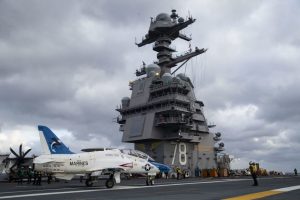The U.S. Navy nuclear-powered Gerald R. Ford-class may end after four flattops, according to acting Secretary of the Navy Thomas Modly.
“I don’t know if we’re going to buy any more of that type,” Modly was quoted as saying by Defense & Aerospace Report earlier this month. He added, “[W]e’re certainly thinking about possible other classes. What are we going to learn on these four that’s going to inform what we do next? But we have some time now, we have up until 2026, 2027 before we have to make a really firm decision on what the next carrier is going to look like.”
Instead of additional Ford-class carriers, the service may opt for smaller and cheaper flattops based on, for example, the “lightning carrier” concept. This shift is partially driven by concerns over the high costs of supercarriers and their increased vulnerability to long-range precision strikes from air, land, and sea. U.S. carrier doctrine might undergo adaptation as a result.
To study the future of the carrier and naval aviation, Modly commissioned a six-month study, the Navy announced yesterday.
“The long-term challenges facing our nation and the world demand clear-eyed assessments and hard choices,” Modly was cited in the press release as saying. “Because we have four new Ford carriers under contract, we have some time to reimagine what comes next. Any assessment we do must consider cost, survivability, and the critical national requirement to sustain an industrial base that can produce the ships we need — ships that will contribute to a superior, integrated naval force for the 2030s and far beyond.”
Notably, the U.S. Secretary of Defense is conducting a separate assessment of the future of large flattops and naval aviation.
The first-of-class USS Gerald R. Ford (CVN-78), commissioned in July 2017, is the most expensive warship in U.S. Navy history, with total procurement cost amounting to around $13 billion.
The Ford’s follow-on, the future USS John F. Kennedy (CVN-79) was christened in late 2019. The flattop’s commissioning date was originally scheduled for 2018, yet later revised to 2020 by then-U.S. Secretary of Defense Robert Gates. The ship is scheduled for delivery to the Navy in 2024 with an initial deployment date set for 2026.
The third carrier of the class, the future USS Enterprise (CVN-80), is expected to join the fleet by 2027, while the fourth Ford-class carrier (CVN-81), the Doris Miller, is expected to enter service with the Navy by 2032.
The Ford class incorporates 23 new technologies. A new U.S. government report revealed problems with three combat systems of the first-of-class USS Gerald R. Ford: the SLQ‑32(V)6 electronic warfare system, the SPY-3 Multi‑Function Radar (MFR), and the Cooperative Engagement Capability (CEC).
“These deficiencies and limitations reduce the overall self-defense capability of the ship,” the Office of the Director of Operational Test and Evaluation (DOT&E) reported.
The study also notes that the carrier “is unlikely to achieve the Sortie Generation Rate (SGR) [number of aircraft sorties per day] requirement.”
The Ford class was designed to increase the SGR by 25 to 30 percent compared to its immediate predecessor, the Nimitz class.

































